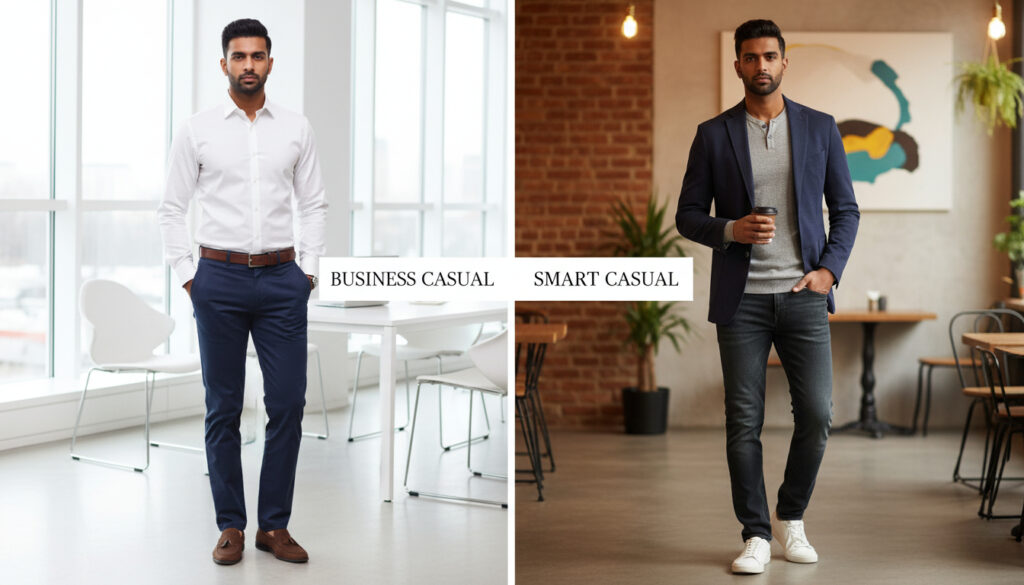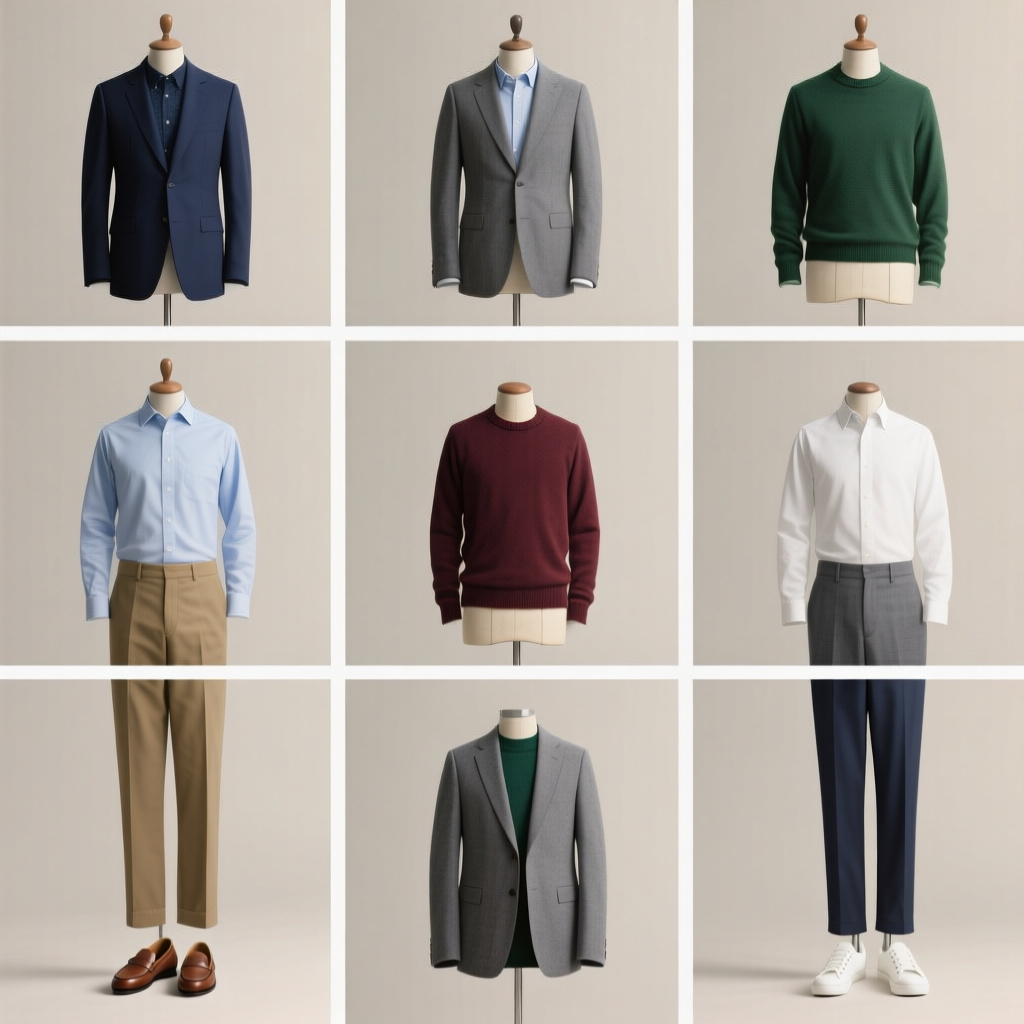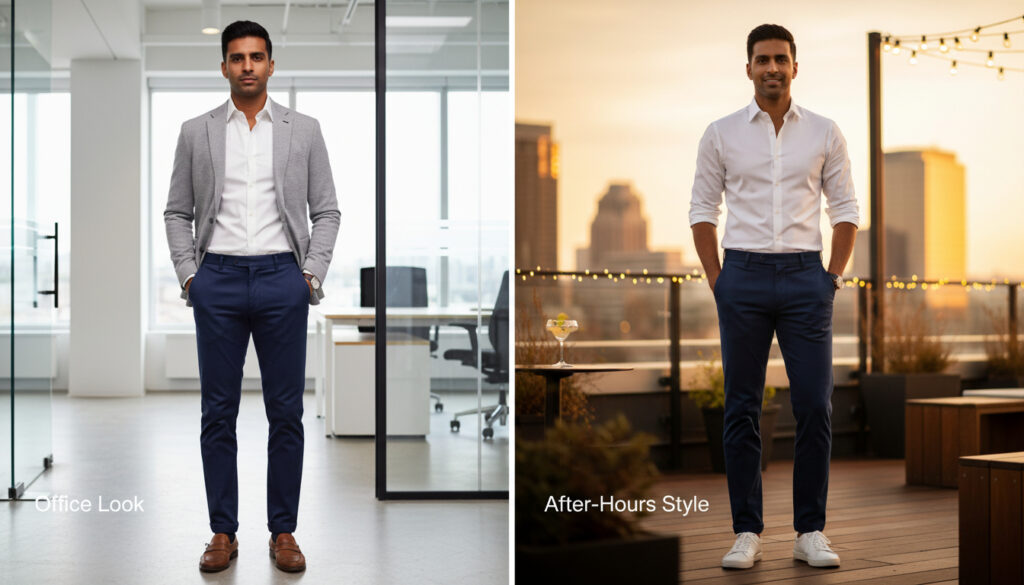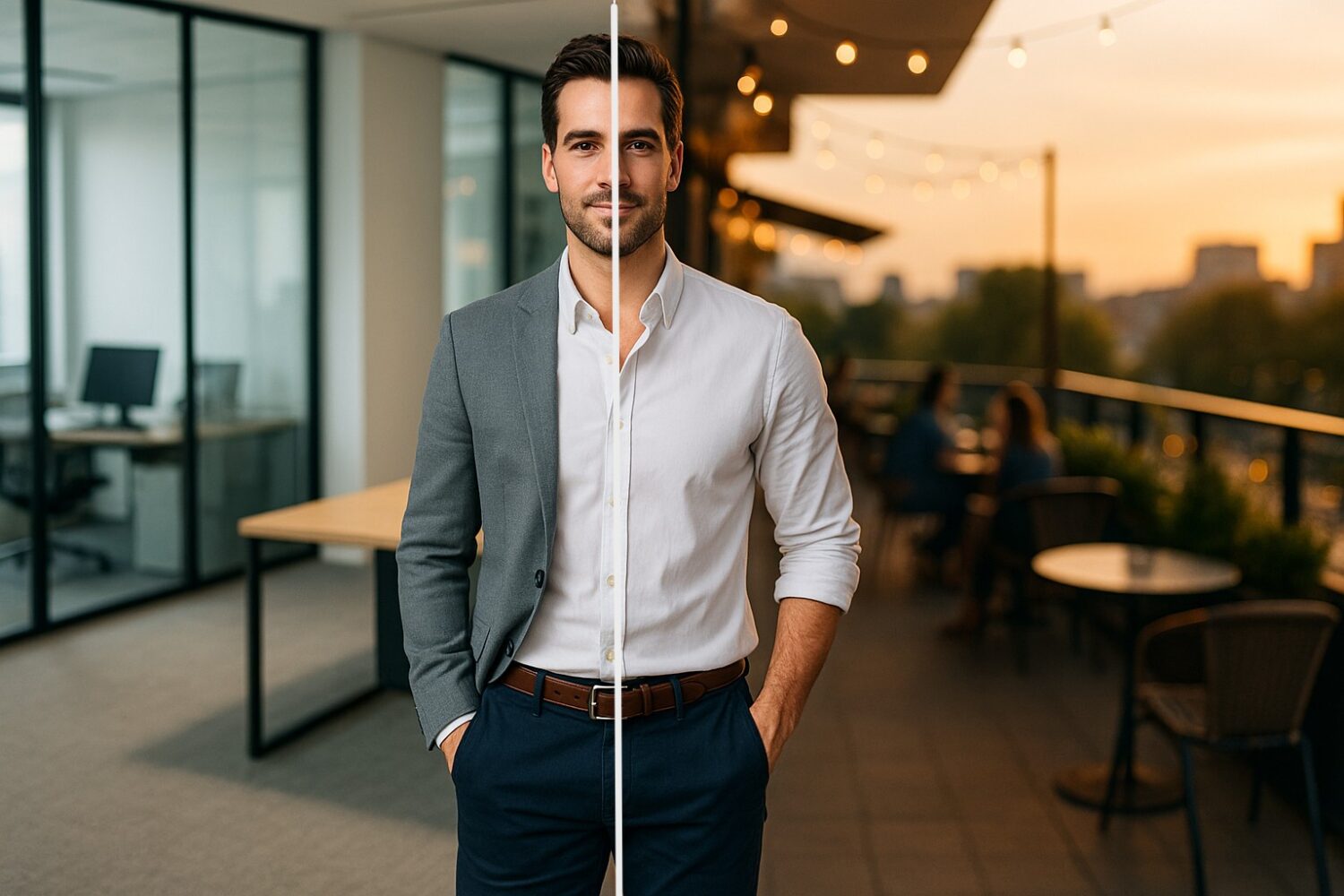The modern workplace has transformed dramatically, with hybrid schedules and flexible dress codes becoming the new standard. Whether you’re navigating video calls from home or returning to the office, business casual remains the professional sweet spot that balances comfort with credibility.
This comprehensive guide delivers clear rules, essential wardrobe pieces, and smart shopping strategies to master business casual this year. Drawing from Men’s Wearhouse trend data, we know that 72% of companies now maintain modified dress codes that prioritize both professionalism and employee comfort.
As your trusted style partner, Men’s Wearhouse combines decades of menswear expertise with cutting-edge performance fabrics to help you look sharp and feel confident in any professional setting.
What Counts as Business Casual Today

Business casual has evolved beyond traditional definitions, shaped by post-pandemic workplace flexibility and hybrid work realities. Today’s business casual acknowledges that professionals need clothing that transitions seamlessly from home office to boardroom, prioritizing both comfort and credibility.
The biggest misconception is equating business casual with weekend casual. While comfort matters, business casual maintains professional standards through quality fabrics, proper fit, and polished details. Workplace surveys show 68% of professionals seek clothing that delivers comfort without sacrificing professional appearance, a challenge Men’s Wearhouse addresses through innovative performance fabric collections.
Think of business casual as a spectrum rather than a rigid uniform. Your industry, company culture, and daily activities all influence where you land on this spectrum. A tech startup might embrace the casual end, while financial services lean toward the business side.
Business Casual vs Smart Casual

Business casual prioritizes workplace appropriateness with polished pieces suitable for client meetings. Smart casual emphasizes style and personal expression for social or creative environments.
Business Casual Example: Navy chinos, white button-down shirt, brown leather loafers, and matching belt.
Smart Casual Example: Dark jeans, heather gray henley, unstructured blazer, and white leather sneakers.
Industry nuances matter significantly. Tech companies often blur these lines, while finance and law maintain stricter business casual standards. When in doubt, observe your workplace culture and lean slightly more formal.
Dress Code Do’s and Don’ts
Do:
- Prioritize proper fit above all else. Men’s Wearhouse data shows 74% of returns stem from poor fit, making professional tailoring essential for polished appearance. Our Tailor-On-Call service ensures every piece fits perfectly for your body type.
- Build your wardrobe around neutral foundations like navy, gray, charcoal, and beige. These versatile colors mix effortlessly and project professional competence—a principle that guides Men’s Wearhouse color palette curation.
- Embrace performance fabrics that offer stretch, moisture-wicking, and wrinkle resistance for all-day comfort and sharp appearance. Men’s Wearhouse leads the industry in performance fabric innovation with collections like Iron Free Premium Khaki™ and Awearness Kenneth Cole Performance.
Don’t:
- Confuse athleisure with business casual. Yoga pants, athletic shorts, and gym shirts belong in fitness settings, not professional environments.
- Wear distressed denim, graphic tees, or clothing with visible logos. These casual elements undermine professional credibility.
- Neglect grooming and shoe maintenance. Scuffed shoes and poor grooming can sabotage even the best-chosen outfit.
FashionBeans research confirms that proper fit influences perception more than brand names or price points. A well-fitted $50 shirt outperforms an ill-fitting $200 shirt every time—which is why Men’s Wearhouse combines quality fabrics with expert tailoring at every price point.
Performance Fabrics and Why They Matter
Performance fabrics are textiles engineered to deliver enhanced functionality like stretch, moisture-wicking, wrinkle resistance, and temperature regulation. These innovations address real workplace challenges from long commutes to climate-controlled offices.
Industry data reveals 65% of shirt purchases now include performance technology, reflecting growing demand for functional professional wear. Modern professionals want clothing that works as hard as they do, a need Men’s Wearhouse anticipated and addressed through comprehensive performance collections.
Men’s Wearhouse flagship examples include Iron Free Premium Khaki™ pants that resist wrinkles through multiple wears and Awearness Kenneth Cole Performance Shirts that wick moisture while maintaining crisp appearance. These innovations solve common pain points: wrinkled clothing after long commutes, discomfort during business travel, and maintaining professional appearance in hot climates.
Performance fabrics prove especially valuable for hybrid workers transitioning between home and office environments. Men’s Wearhouse stretch-infused chinos provide comfort for desk work while maintaining structure for video calls and in-person meetings.
Business casual vs business professional: key differences
Business casual emphasizes comfort and flexibility while maintaining professional appearance, whereas business professional demands formal structure and traditional suiting. The key differences lie in fabric weight, silhouette structure, and styling flexibility.
- Silhouettes: Business casual allows unstructured blazers and relaxed fits. Business professional requires structured suits with defined shoulders.
- Fabrics: Casual embraces stretch cotton, performance blends, and knits. Professional demands wool, fine cotton weaves, and formal textiles.
- Footwear: Loafers and leather sneakers work for casual. Professional requires dress shoes like oxfords or derbies.
- Accessories: Casual skips ties, allows casual watches. Professional includes ties, formal timepieces, and pocket squares.
Elevate business casual for important meetings by adding a structured blazer over your polo, swapping loafers for dress shoes, or incorporating a subtle tie with your button-down shirt.
Business casual by industry: tech, finance, creative, and more
Business casual varies significantly by industry. Tech companies accept dark jeans, performance polos, and clean leather sneakers, while finance and legal require chinos, button-down shirts, and classic loafers. Education and healthcare admin favor stretch khakis with moisture-wicking shirts for all-day comfort, and creative fields welcome personal expression through patterned shirts or colored chinos.
Regional differences matter considerably. West Coast offices embrace relaxed interpretations, while East Coast environments maintain traditional standards. When starting new roles or attending important meetings, read the room and err slightly more polished than observed norms. Adding a navy blazer to your usual outfit instantly shows respect for company culture while maintaining professional credibility. Observe senior colleagues during your first week to understand unwritten dress code expectations, then adjust accordingly.
Core Pieces of a Modern Business Casual Wardrobe

The “3-piece versatility rule” should guide every wardrobe investment: each garment must work effectively in three different scenarios. This approach maximizes value while minimizing closet clutter, essential for modern professionals balancing multiple work environments.
Focus on quality over quantity, investing in pieces that transition seamlessly from casual Friday to client presentations. Neutral colorways and performance fabrics form the foundation, with seasonal adjustments for fabric weights and styling details.
Shirts and Polos That Stay Sharp All Day

Dress shirts remain business casual cornerstones, with button-down collars offering the perfect balance of structure and relaxation. Men’s Wearhouse wrinkle-resistant fabrics in white, light blue, and subtle patterns photograph well on video calls while maintaining professional appearance throughout long workdays.
Knit polos provide comfortable alternatives that maintain professional appearance. Men’s Wearhouse structured collars and quality cotton or performance blends resist shrinking and fading. Navy, gray, and white polos integrate seamlessly with chinos and blazers.
Collar styles matter for versatility. Spread collars work with or without ties, button-down collars offer casual flexibility, and band collars provide modern minimalism. Consider Men’s Wearhouse Tailor-On-Call service for perfect fit across different collar styles.
Moisture-managing fabrics keep you comfortable during long workdays, while stretch materials accommodate movement without compromising professional silhouette. Invest in at least five quality shirts to enable weekly rotation without repetition.
Chinos, Dress Pants and Dark Jeans
Chinos bridge the gap between casual and formal, offering versatility that works from coffee meetings to client dinners. Men’s Wearhouse classic fits like slim or athletic cuts complement your body type without being restrictive.
Dark jeans earn business casual acceptance when they’re clean, well-fitted, and free from distressing. Deep indigo or black denim paired with blazers or button-down shirts creates polished casual looks appropriate for creative industries and casual Fridays.
Stretch-infused chinos represent Men’s Wearhouse’s top-selling category, combining professional appearance with all-day comfort. Our premium collections feature 2-5% elastane content that provides flexibility without compromising structure.
Blazers, Sweaters and Lightweight Layers

Unstructured blazers offer professional polish without formal rigidity, making them perfect for business casual environments. Merino wool sweaters provide sophisticated layering options that work alone or under blazers. V-necks showcase shirt collars, while crew necks offer clean minimalism. Quarter-zip sweaters bridge athletic and professional aesthetics.
Shoulder construction determines blazer versatility. Unstructured shoulders create relaxed silhouettes perfect for layering, while soft construction maintains shape without formal stiffness. Our sales data shows blazer-with-jeans combinations grew 27% as professionals embrace elevated casual styling.
Layering formulas accommodate variable office temperatures and seasonal transitions. Master the blazer-over-polo combination for warm weather and sweater-under-blazer for cold climates.
Shoes and Accessories That Finish the Look
Leather loafers provide versatile sophistication that works with chinos, dress pants, and dark jeans. Includes brown and black leather in classic penny or tassel styles that complement your wardrobe’s color palette.
Clean leather sneakers earn acceptance in modern business casual environments when they’re minimal, neutral-colored, and well-maintained. White, gray, or navy sneakers in premium leather offer comfortable alternatives to traditional dress shoes.
Color coordination between belts and shoes creates visual cohesion. Match leather tones rather than exact colors, brown belts with brown shoes, black belts with black shoes. This classic rule maintains professional polish.
Footwear Glossary:
- Derby: Open-laced dress shoe with casual versatility
- Loafer: Slip-on shoe perfect for business casual
- Chelsea Boot: Ankle boot with elastic sides for modern edge
Minimal watches, quality socks, and leather accessories complete business casual looks without overwhelming them. Choose accessories that enhance rather than distract from your professional image.
Men’s business casual essentials checklist
Build your professional foundation with these versatile pieces that transition seamlessly from video calls to client meetings.
- Shirts: White and light blue button-downs in modern or slim fit, performance polos in navy and charcoal with moisture-wicking fabric
- Pants: Navy and charcoal chinos in classic or athletic fit, stretch-infused fabric for comfort, light sand for versatility
- Layers: Unstructured blazers in navy or charcoal, merino wool crew neck sweaters, quarter-zip pullovers for refined layering
- Footwear: Brown and black leather loafers, clean leather sneakers in white or navy for modern offices
- Essentials: Matching leather belts, minimal watch, quality dress socks in neutral tones
Focus on performance fabrics that resist wrinkles and provide stretch for all-day comfort while maintaining professional polish.
Styling Business Casual Outfits for Any Workday
Building a capsule wardrobe starts with establishing a cohesive color palette that maximizes mixing potential. Follow these numbered steps to create a versatile foundation that works across different professional scenarios.
- Start with neutral base colors (navy, gray, white, khaki) for major pieces
- Add one accent color (burgundy, forest green, or subtle patterns) for variety
- Ensure every piece coordinates with at least three others
- Consider your industry’s cultural norms and adjust accordingly
Entry-level professionals should prioritize versatile basics that transition from interviews to daily work. Mid-career workers can invest in quality fabrics and subtle personal style elements. Executive-level dressing emphasizes premium materials and impeccable tailoring.
Building a Versatile Color Palette
The 70-20-10 rule creates balanced, professional wardrobes. Allocate 70% to neutral foundations (navy, gray, white, beige), 20% to muted supporting colors (light blue, sage, burgundy), and 10% to statement accessories (pocket squares, ties, watches).
Neutral foundations provide maximum versatility and professional credibility. Navy and gray serve as universal bases that work across seasons and situations. White and light blue shirts brighten any combination while maintaining professional standards.
Muted accent colors add personality without overwhelming professional appearance. Burgundy, forest green, and subtle patterns introduce visual interest while remaining workplace-appropriate. These colors work especially well in sweaters, ties, and accessories.
Transitioning from Office to After-Hours

Modular dressing enables quick transitions from professional to social settings with minimal wardrobe changes. Swap dress shoes for clean sneakers, remove blazers, or roll shirt sleeves for instant casual transformation.
Office Look: Navy chinos, white button-down, gray blazer, brown loafers After-Hours Transformation: Same chinos and shirt, remove blazer, swap loafers for white leather sneakers
Accessory swaps provide subtle transitions. Replace formal watches with casual alternatives, switch leather belts for canvas options, or add casual jackets over work shirts. These small changes shift perception without requiring complete outfit overhauls.
The key is choosing pieces that work in multiple contexts rather than maintaining separate work and casual wardrobes. This approach saves money, closet space, and decision-making time.
Seasonal Strategies for Heat, Cold and Travel
Hot Weather Solutions: Linen-blend shirts offer breathability while maintaining professional structure. Unlined blazers provide polish without excessive warmth. Light-colored chinos reflect heat while darker tops hide perspiration. Men’s Wearhouse performance fabrics with moisture-wicking properties keep you comfortable during summer commutes.
Cold Weather Layering: Merino wool sweaters provide warmth without bulk, fitting comfortably under blazers. Insulated but tailored outerwear maintains professional silhouette while providing weather protection. Dark colors hide winter wear while neutral accessories brighten cold-weather looks.
Travel Considerations: Packable, wrinkle-resistant fabrics minimize luggage space and arrival preparation time. Shoe bags protect leather footwear while separating clean and worn items. Versatile pieces that work in multiple combinations reduce packing requirements while maintaining professional options.
Why Men’s Wearhouse Is the One-Stop Hub
Men’s Wearhouse combines comprehensive selection with professional expertise that mass-market retailers cannot match. On-site tailoring ensures perfect fit across different brands and body types, while extensive size ranges accommodate diverse customer needs.
The hybrid shopping model integrates online convenience with in-store fitting expertise. Browse selections online, then visit stores for professional fitting and tailoring services. This approach saves time while ensuring optimal results.
Performance collections like Awearness Kenneth Cole and Joseph Abboud offer cutting-edge fabric technology at accessible price points. These exclusive partnerships provide innovation typically found only in premium brands.
Customer satisfaction scores reflect this comprehensive approach, with professional tailoring services receiving consistently high ratings from business casual shoppers seeking long-term wardrobe solutions.
Budget-Friendly Brands and Mass-Market Stores
Target’s Goodfellow & Co. provides basic business casual pieces at accessible price points, though fabric quality and tailoring options remain limited. Uniqlo offers performance basics with clean design aesthetic, particularly strong in dress shirts and chinos.
Kohl’s and JCPenney provide frequent sales on brand-name business casual wear, making quality pieces more affordable during promotional periods. However, selection consistency and sizing can vary significantly.
Compared to Men’s Wearhouse clearance pricing and Rewards Program benefits, mass-market savings often diminish when factoring in alteration costs and replacement frequency. Quality trade-offs include fabric durability, fit precision, and professional styling details that Men’s Wearhouse delivers consistently.
Performance and Premium Labels Worth the Upgrade
Awearness Kenneth Cole represents Men’s Wearhouse’s flagship performance collection, combining innovative fabrics with contemporary styling. Stretch chinos, moisture-wicking shirts, and wrinkle-resistant blazers deliver professional functionality that justifies premium positioning.
Joseph Abboud Reserve offers premium fabric innovation with Italian mills and advanced construction techniques. These pieces justify higher price points through superior durability, comfort, and professional appearance that competitors struggle to match.
“The performance fabrics make such a difference during long workdays—I stay comfortable and look sharp from morning meetings to evening events.” — Verified customer review
Men’s Wearhouse premium labels emphasize fabric sourcing, construction quality, and design details that enhance professional credibility. While initial investment is higher, cost-per-wear calculations often favor quality pieces over budget alternatives. Mastering business casual in 2025 requires understanding modern workplace realities while maintaining professional standards. The key lies in building a versatile wardrobe around performance fabrics, neutral colors, and quality construction that adapts to hybrid work environments.
Men’s Wearhouse provides the expertise, selection, and tailoring services necessary to navigate this evolution successfully. From performance chinos to wrinkle-resistant shirts, our curated collections address real workplace challenges while maintaining the professional polish that builds career credibility.
Start with the fundamentals—well-fitted chinos, quality button-down shirts, and versatile blazers—then build your wardrobe strategically around pieces that work in multiple scenarios. Remember the 3-piece versatility rule: every garment should function effectively in three different professional situations. This approach maximizes value while ensuring you’re prepared for any workplace challenge 2025 presents.
Summer business casual: a week of outfit ideas
- Light blue cotton-linen blend shirt with navy stretch chinos and brown leather loafers. Swap to a white performance polo for hotter days.
- Navy knit polo with khaki stretch chinos and white leather sneakers. Add an unlined blazer for cooler offices.
- White button-down with charcoal chinos and suede loafers. Roll sleeves and remove belt for casual Fridays.
- Light gray polo under an unlined navy blazer with stone-colored chinos. Remove blazer when temperatures rise.
- Sage green button-down with navy chinos and brown oxford shoes. Switch to moisture-wicking performance fabric for humid climates.
- White polo with light sand chinos and canvas sneakers. Layer with a lightweight cardigan for air-conditioned spaces.
These breathable combinations mix effortlessly throughout the week. Performance fabrics with stretch technology keep you comfortable during long commutes while maintaining that polished professional appearance your career demands.
Frequently Asked Questions
Yes, choose clean, deep-indigo or black jeans with no distressing, pair with a blazer or button-down, and finish with leather shoes for polish. Avoid light washes, rips, or excessive fading that compromise professional appearance. The key is selecting dark denim that maintains the refined standards expected in business casual environments.
Five interchangeable tops and three bottoms create a 15-combo matrix that keeps looks fresh while minimizing closet overload. Focus on versatile pieces that mix and match rather than complete outfit sets. This approach maximizes wardrobe efficiency while maintaining professional variety throughout the week.
Sleek, low-profile leather sneakers in neutral colors work in many modern offices, but confirm your company’s policy first. Choose minimal designs in white, gray, or navy that complement professional attire. Avoid athletic or sporty styles that blur the line between workplace and gym wear.
Look for athletic fits with extra seat and thigh room, or big-and-tall lines with longer torsos and proportional sleeve lengths for balanced drape. Men’s Wearhouse offers specialized sizing across these categories and provides professional tailoring services to achieve optimal fit for any body type.
Performance fabrics deliver stretch for all-day comfort, moisture-wicking for temperature control, and wrinkle resistance for sharp appearance during long workdays. These innovations address practical workplace challenges while maintaining professional standards. Men’s Wearhouse features performance options like Iron Free Premium Khaki™ and Awearness Kenneth Cole Performance Shirts.
Business casual maintains workplace appropriateness with structured pieces like chinos, button-downs, and blazers. Smart casual allows more relaxed elements like dark jeans, polo shirts, and casual footwear for social or creative environments. Business casual prioritizes professional polish while smart casual emphasizes personal style within refined boundaries.
Build around 70% neutrals (navy, gray, beige), 20% muted colors (burgundy, forest green), and 10% statement accessories. This ratio ensures maximum versatility while allowing personality to show through strategic color choices. Neutral bases create endless mixing opportunities across seasons and occasions.

